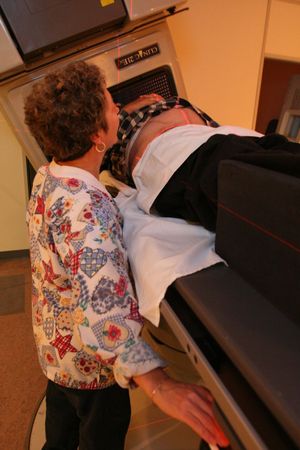



The Fundamentals of Radiation Oncology
What is radiation treatment?

Radiation is loco-regional treatment of cancer.
Surgery is local treatment and chemotherapy is systemic treatment.
Radiation therapy is the treatment of cancer and other diseases with ionizing radiation. Ionizing radiation deposits energy that injures or destroys cells in the area being treated (the "target tissue") by damaging their genetic material, making it impossible for these cells to continue to grow. Briefly, radiation causes damage by delivering energy (the amount of which is measured as a "dose" of radiation) to the tissues. Free radicals are thereby created, which in turn cause the damage to the cellular DNA. Since cancer cells cannot repair this damage as effectively as normal tissues, they are preferentially killed by radiation treatments.
The total dose of radiation is not given all at once. It is fractionated over time depending on many factors including the goals of treatment.
Unlike cancer cells, most normal tissues recover from the effects of radiation. To protect normal cells, radiation oncologists carefully limit the doses of radiation and spread the treatment out over time. They also shield as much normal tissue as possible while they aim the radiation at the site of the cancer.
External beam radiotherapy uses machines to focus radiation on a cancer site. Depending on the amount of energy it possesses, the radiation can be used to destroy cancer cells both on the surface and deeper in the body. The higher the energy of the beam, the deeper the radiation can penetrate into the target tissue. X-ray machines, cobalt units and linear accelerators are all examples of external beam radiation.
Internal radiotherapy, or brachytherapy, places radioactive implants directly in a tumour or body cavity, these can be permanent or removable. "Brachy" is Greek for "short distance" and in brachytherapy the radioactive sources are placed in contact or close proximity to the target tissue. The intent is to deliver a high radiation dose to the tumor while limiting the absorbed dose to surrounding healthy tissues in the body.
Radiation is used with curative intent, as primary, adjuvant or combined modality treatment. Radiation is also used for palliative benefit.
Radiation treatment depends on the availability of a highly trained team and increasingly advanced equipment. Access to cancer centres is a major determinant of treatment. The global availability of treatment is of concern.[1]
Radiation for Cure
Radiation may be given for local control of disease or with curative intent.
Curative treatment occurs over a longer period of time with a lower dose per treatment (fraction). The acute side effects may be severe and late side effects need to be considered as well. The following factors determine therapeutic and side effect response to treatment.
Tumour factors | tumour size - number of clonogenic cells intrinsic radiosensitivity of cells tumour microenvironment - hypoxia |
Normal tissue factors | radiation sensitivity capacity for repopulation value of normal tissue |
Technical factors | accurate definition of target volume reproducibility of set up for treatment |
Radiation can be primary treatment for organ preservation (larynx, anus, bladder), when the tumour is too extensive for surgery (nasopharyngeal, cervix, prostate) or the patient is unfit for surgery (lung, esophagus).
Highly radiosensitive tumours: seminoma testis, Hodgkin’s Disease, epithelial skin cancer.
Radiation as Adjuvant Therapy
Radiation can enhance local-regional control of disease and may be considered to allow preservation of function or cosmesis. Breast cancer recurrence rates drop from 30% to 8% with adjuvant radiation therapy, and rectal cancer recurrence rates drop from 40% to 15 %.
Combined Modality Treatment
Radiation is most commonly used for combined modality treatment of rectal, lung, anal and esophageal cancer. In combination radiation can improve cure rates, decrease toxicity and decrease morbidity.
Radiation for Palliation
Radiation provides palliative benefit in:
bone pain
spinal cord compression
brain metastases
bronchial obstruction
hemoptysis
esophageal obstruction
pelvic pain or bleeding
ulcerating subcutaneous masses
In palliative situations radiation treatment tends to occur at a higher dose per fraction over a shorter period of time. For example, a painful bone met might be treated with a single fraction of 800cGy. In other situations radiation treatment may be given at a lower dose per fraction over a longer period of time (the number of fractions ranging from 5 to 35 in these sorts of treatment). This is obviously a more disruptive and demanding course of treatment, with higher rates of side effects. Quality of life, disruption to the patient and avoidance of acute side effects play a more prominent role when giving radiation for palliative purposes.
_________________________________
1. Bhadrasain V. Radiation therapy for the developing countries . J Can Res Ther [serial online] 2005 [cited 2008 Mar 13];1:7-8. Available from: http://www.cancerjournal.net/text.asp?2005/1/1/7/16083 https://tspace.library.utoronto.ca/bitstream/1807/5395/1/cr05003.pdf accessed March 13, 2008
 Previous
Previous